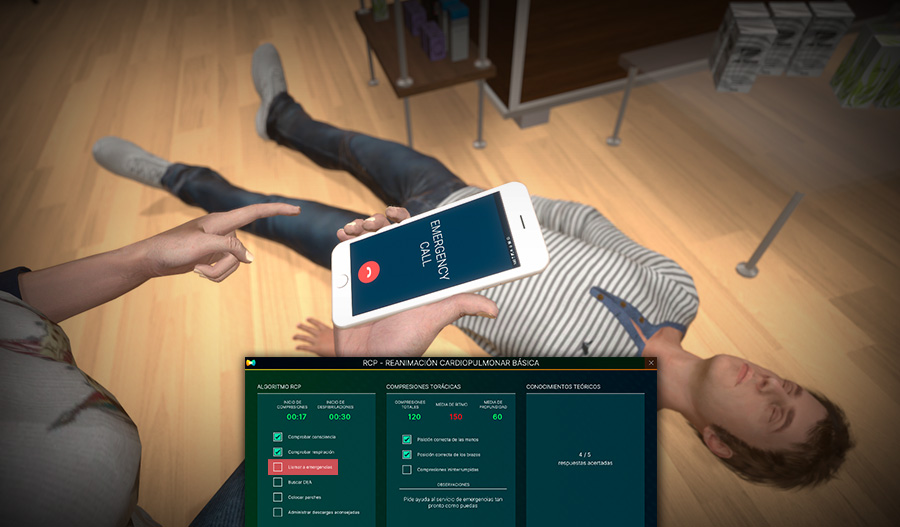What is choking?
Choking occurs when a foreign object becomes lodged in the throat, blocking the airway. It can be mild, where the person can still cough or speak, or severe, which can be life-threatening.
Thousands of choking-related deaths every year
While many have experienced or witnessed minor choking incidents, thousands of lives are lost to choking annually. In Spain alone, 2,994 deaths were reported due to choking in 2021.
This data, based on Spain's National Institute of Statistics (INE), ranks choking as the third leading external cause of death, following suicides (4,003) and accidental falls (3,655).
First aid techniques, such as the Heimlich maneuver, play a crucial role in saving lives during choking incidents. It’s a simple procedure that everyone should learn, as choking can happen to anyone at any time.
One choking-related death every 3 hours in Spain
The 2,994 choking deaths in Spain in 2021 equate to an average of 8.2 deaths daily—about one every 3 hours. This figure underscores the gravity of choking incidents, which take more lives than many people realize.
With Spain's 2021 population of 47,331,302, the incidence of choking deaths was 6.3 per 100,000 people. While not all of these deaths are preventable, performing the Heimlich maneuver during a total airway obstruction can save lives.
A 19% increase in choking deaths in Spain
Choking-related deaths have risen yearly, much like other types of accidents. In 2020, 2,511 choking deaths occurred in Spain—483 fewer than in 2021. This marks a concerning 19% year-over-year increase, equivalent to nearly two additional deaths per day.
Over 5,000 choking deaths annually in the U.S.
In the United States, choking is the fourth leading external cause of death. Approximately 5,325 people died from choking in 2021, according to data from Statista and the National Safety Council.
This figure translates to more than 14 deaths per day, or one choking-related death every 1.6 hours. It reflects a slight increase from the 4,963 deaths reported in 2020. The choking death rate in 2021 was 1.6 per 100,000 people.
What to do in a choking emergency
When faced with a choking incident, determine whether the airway obstruction is mild or severe. If the person cannot cough, speak, or breathe, their life is at risk, and you should perform the Heimlich maneuver immediately.
The Heimlich maneuver: key to fighting choking
Emergency techniques like the Heimlich maneuver can significantly reduce the alarming number of deaths caused by choking.
Invented in 1974 by Dr. Henry Heimlich, the maneuver has saved countless lives. Interestingly, Dr. Heimlich tested the technique on dogs during its development, a decision that sparked controversy at the time.
Yes, the Heimlich maneuver can even be performed on pets, potentially saving them from suffocation. Its versatility is one of its greatest strengths—anyone can learn to perform it, and you can even perform a self-Heimlich maneuver if you're alone during a choking incident.
However, barriers like lack of realism in training, theoretical instruction without practical application, and insufficient stress simulation often hinder widespread first-aid knowledge. These challenges can now be overcome with advanced technology.
Virtual Reality (VR) for first-aid training
Virtual reality (VR) creates realistic simulations of real-life scenarios. With VR goggles, users are fully immersed in the experience, providing a dynamic and interactive training environment.
Ludus has brought VR technology into first-aid training. Its choking simulation places users in a dining hall scenario, where they must respond to a choking incident under realistic stress. Trainers can customize various variables, and participants learn to react appropriately in high-pressure situations.
By allowing participants to make mistakes (e.g., offering water to the victim) and see the consequences, the simulation reinforces correct responses. It prepares users to act decisively and save lives.
Ludus offers an extensive platform of VR simulations for clients, covering areas like fire extinguishing, CPR, workplace accident prevention, construction safety, and more. With a subscription license, clients gain unlimited access to all available content.
Are you interested in Virtual Reality as a tool for health and safety training?
Fill out this form to receive specific information about the benefits and features of our VR platform.








